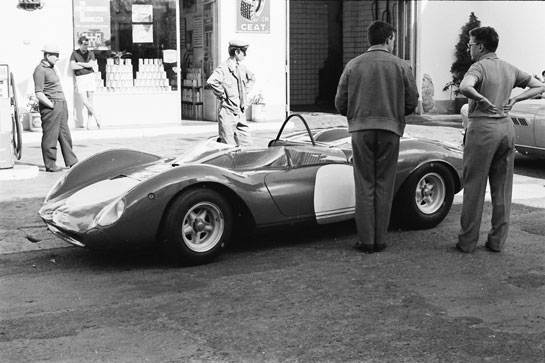
This Dino 206S was seen again at the Algarve Historic Festival in Portugal. Here it is in 1965 at the Cesana-Torinese hill climb, its first outing as a hill climb car. Driver Ludovico Scarfiotti has his back to the camera and team manager Eugenio Dragoni.
Four from Portugal, by Graham Gauld
I have been humbled by the response to the first column and only hope I can keep you entertained for a few more months. I think one of the problems is that each chance meeting or race meeting provides an opportunity to dig out even more stories to flesh out information we have on some of the odder pieces of motor sport history. They might otherwise disappear when boring old farts like me arrive at the eventual pit stop hopefully in the sky.
This opportunity to flesh out more information was underlined for me a couple of weeks ago at the final big International European historic meeting, the Algarve Historic Festival in Portugal.
The organiser, Francisco Santos is a former Portuguese rally champion and saloon car racer so he has the enthusiasm and empathy to put on a meeting with some great cars and drivers. For me it launched a few more fascinating stories. Let me give you four examples.
Koala
Thirty five years ago a young Australian called Roger Ealand came to the Scottish race circuit, Ingliston, with his Marcos-Volvo. Remember it, long, lithe and fast (the car that is!). He was a regular winner at the track and then disappeared.
Imagine my surprise when we had a cheerful reunion in the paddock at Portomaio circuit but this time he had a single seater Formula Junior. The car was completely new to me and called the Koala which Roger claims was the first Australian-built Formula Junior. It was the creation of a 19 year old teenager called John Vincent Joyce who built it from scratch and raced it. John was later to design the Bowin, another Australian rarity. However, the young lad was espied by a certain Colin Chapman who was in Australia for the Tasman Series and sweet-talked him into coming to England and working for Lotus.
John Joyce was born in 1938 and died of a heart attack in 2002, He joined Lotus as a project engineer but was soon made Chief Development engineer and worked not only on the Formula 1 cars but the Indianapolis Lotuses for Dan Gurney and Jim Clark. When he returned to Australia he thought the time was right to found a racing car company and so founded Bowin Designs Pty. In the next eight years he built over fifty Bowins for various categories including F5000 but his Formula Fords were particularly successful. You can still find the odd Bowin racing today. However, despite consultancy work with Ford, Joyce branched out into designing gas appliances, developed a gas burner that reduced emissions and was continuing to work on the project when he had his fatal heart attack.
SUPPORT VELOCETODAY BY BECOMING A PREMIUM SUBSCRIBER
It would be good to say that Roger Ealand took the Koala to brilliant success in Portugal against the other Formula Junior but sadly it was not the case but it is great to see a unique car like this back in historic motor racing.
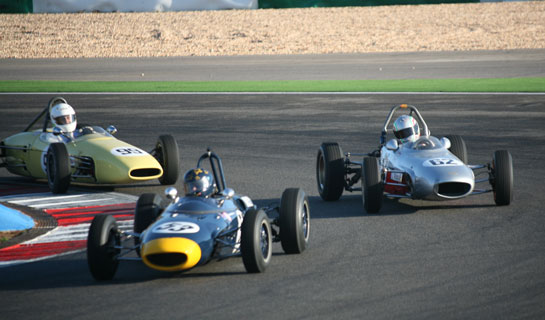
Talking of Formula Junior, the first of two races was won by Tommaso Gelmini in a Branca which was a tremendous result for this small Italian concern against the Brabham, Lotus and Lola competition. In fact it is probably the first major International F Junior win by a Branca.
Ferrari
Ferraris didn’t have a good weekend in Portugal but two of the cars were very special. Both are owned by collector Harry Leventis who not only had the Ferraris but his Aston Martin DBR1 taking part.
One of the two Ferraris has a special place in my memory because I saw it on its first appearance as a factory hill climb car at the 1965 Cesana-Torinese hill climb, one of the European Hill Climb Championship events. This Championship carried a lot of prestige and Ferrari were out to win it that year with Lodovico Scarfiotti.
Earlier in 1965 they had produced a squat little Dino 206S Coupe at Nurburgring that had performed well. They took it back to the factory and literally sawed the roof off it and turned it into a hill climb car; and Cesana-Torinese was its debut event. This was the third event in the Championship and Gerhard Mitter’s Porsche Bergspyder looked like it was going to walk the series. When Scarfiotti lined up with the car – it looked a bit tatty and you could still see the hammer marks where they had hastily cut off the roof and tried to smooth out the rear deck- fireworks were to follow. Scarfiotti – supported by Ferrari team manager Eugenio Dragoni – wiped the floor with everyone and went on to win the championship. It was this car that led to the development of the other hill climb car, the 212E.
At the end of that season it was rebodied with the upswept tail it has today and was given to Jonathan Williams to run in the Targa Florio of 1966. After a few private owners, including Carlos Monteverde, it was bought by Harry Leventis and now it was in Portugal with Richard Attwood and Bobby Verdon-Roe at the wheel. Sadly Attwood, despite being challenged in the early stages by the E type Jaguar of Martin Stretton, was well in the lead when a wishbone broke and he was out. The other Leventis Ferrari, the even more spectacular long tail 246S also retired in the race for the Stirling Moss Trophy: a two hour race that started as night fell and won by the Lister-Jaguar driven by Gary Pearson and Alex Buncombe.
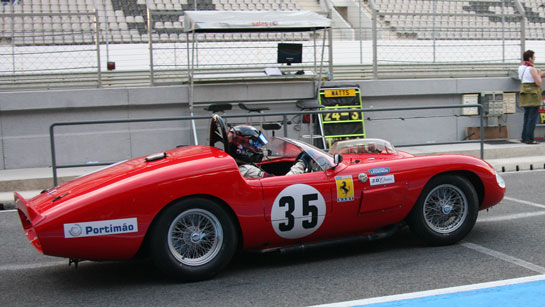
I just loved this long tail 246S Dino raced by Gregor Fisken and seen dashing down the pit lane in Portugal.
Tec-Mec
The Historic Grand Prix Cars Association runs a series of events in Europe for grand prix cars of various categories and I was particularly interested in the pre-61 race because there were a real variety of cars of all ages right down to two 1934 racers, Rainer Ott’s R9B ERA and Stephan Rettenmaier’s Maserati 4CM. However the car that interested me was Barrie Baxter’s Tec-Mec Maserati, the car designed by Valerio Colotti, better known for his Colotti gearboxes. Barrie has owned the car for a number of years and thanks to the help of Rick Hall at Hall & Hall it has come from being a back marker in its early days to a potential race winner; as it was in Portugal.
The Tec-Mec story is pretty well known. Maserati pulled out of grand prix racing in 1957 and Colotti, who was working with the company at the time, decided to form his own design studio providing a service to anyone wanting any work done. He had already been working on a possible 1958 Maserati grand prix car with a multi tube chassis and independent suspension but this had been put aside.
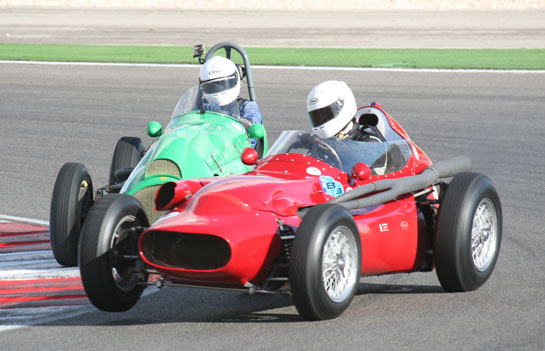
Barrie Baxter lifts a wheel of the Tec-Mec when trying to hold off young Will Nuthall in the ex-Bob Gerard Cooper-Bristol.
I believe it was Giorgio Scarlatti who asked him to resurrect the project that was to develop into the Tec-Mec ( After Colotti’s company name, Studio Tecnica Meccanica). However Scarlatti sold his interest in the project to an American, Gordon Pennington, who was living in Modena at the time. Pennington managed to buy a Maserati 250F engine and this Colotti-designed Tec-Mec was started as a spare time job by a group of Maserati mechanics. However they didn’t get the car finished in time for the Italian Grand Prix of 1959. Pennington therefore decided to give the car its debut in the October 1959 US Grand Prix at Sebring – the first US based World Championship grand prix.
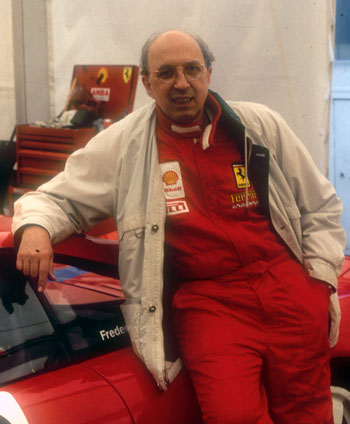
The only man to race a Tec-Mec in a world championship grand prix, Fritz D’Orey photographed in the late 1990s when he returned to racing in the Ferrari 355 Challenge.
The driver was Brazilian Fritz d’Orey who came from a wealthy family in the car trade. He was a pretty wild driver and came to Europe and had his first grand prix race at the French Grand Prix in 1959 in a Scuderia Centro Sud Maserati. Despite having a huge accident in the Centro Sud car at Silverstone he was selected to drive the Tec-Mec at Sebring. It was a disaster. The engine was a dog and blew up after six laps. Fritz was to go on to race and crash in a number of events until a huge one in a Ferrari caused him to retire from racing.
However, about twelve years ago, I was at the Ferrari Challenge weekend at Enna in Sicily when who should I bump into but Fritz D’Orey driving a Ferrari 355 in the modern challenge series. He is quiet spoken and charming. When I asked him about his sojurn in the Tec-Mec he looked up into the sky, rolled his eyes, and said “…..what a terrible car, it would not go round corners and it ran with two of the cylinders cutting in and out”.
The Tec-Mec eventually ended up in Tom Wheatcroft’s museum at Donington and was then sold to Barrie Baxter. As Rick Hall remarks. “The car has been worked on for a number of years and I think we now have it running properly, as it should have run when it was new”.
Certainly in the race in Portugal Barrie Baxter drove it up from fourth place to win. However, it was to be his last win in the car as he sold the car to Barry Wood actually at the circuit. Ironically Barry Wood’s son Tony Wood, finished second to the Tec-Mec with the family Cooper Bristol. Barry Wood is thrilled to have the car. “…I have been interested in Maseratis for some time and when Barrie told me he was selling the Tec-Mec, that was it. I have bought it with its present engine and what was apparently the original engine and so it will be entered for the Monaco Historics in 2012”.
Bond Formula Junior
In the Formula Junior races in Portugal there were two other very rare cars, the Bonds. The Bond Junior was very advanced for its time in 1960 as it had a monocoque chassis, was front engined and had front wheel drive. Its creator was Laurie Bond, better known for building the Bond three-wheel road car and the Bond Bug. Along with Jon Goddard-Watts, Bond produced the Bond Formula Junior that was debuted by Jon Goddard-Watts at Goodwood in 1961. The company folded, however, having built just one car and the bits for a second one. Move forward forty five years and Jon Goddard-Watts, having sold out his company, decided to seek the Bond Junior. He was able to buy the Mark 1 and the bits for the Mark II which he handed over to engineer Andrew Tart to rebuild. So now there are two Bond Juniors, looking splendid and raced by Andrew Tart and Gil Duffy.
Jon Goddard-Watts’ name came up recently in a conversation I had with ex-Ferrari driver Jonathan Williams. One of the first cars Jonathan raced was the motor cycle-engined Berkeley that won a number of races in the hands of Goddard-Watts. The Berkeley was something special and back in the early 1960s I was able to road test almost every model from the original right up to the 950cc model which was “ fear on wheels “ and I am amazed more owners were not killed driving a car that had too much power for its lightweight frame and Fibreglass body and had a tendency to understeer on tricky high speed corners!
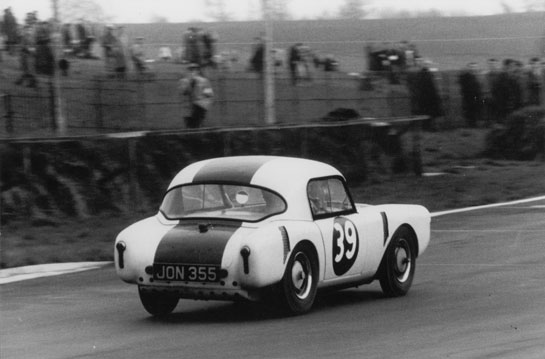
The Berkeley front wheel drive sports car raced by Jon Goddard Watts in the 1950s and later by Ferrari driver Jonathan Williams on his way up.
How we all survived these days I do not know but thank goodness we did or else you would not be reading this column.
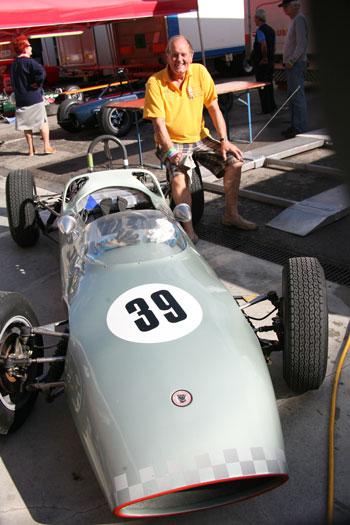
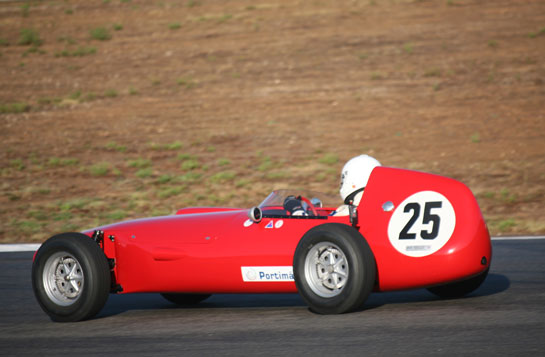

Greetings Graham
We last met at the museum in Mougins…..a few moons back.
The mention of the Berkley and “not getting killed” rings true with me. When I was still an engineering undergraduate at Auburn Univ. in 1959 an acquaintence came back from Christmas holidays with a new Berkley.
He entertained any of us brave/crazy enough to ride with him and he would get up to at least 50 mph on a narrow 2 lane road and “do a 180” at speed. That was my first experience in a FWD car. How the car remained upright and on the pavement still remains a mystery of luck over physics. I can still hear the whine of the motorcycle engine and (probably) chains. I lived the experience twice, once at night, and decided not to push my luck anymore.
Please keep the stories coming.
Best regards
Stephen Dean
Clovis, CA
Graham,
Greetings from Dubai. Much enjoying your reminiscences as always, and trust you are well
Fond regards, Will
Hello Graham ,
You may not remember me but you did a piece on my 1967 Toyota Sports 800
in Hong Kong for a local car magazine called DRIVE . That was in the early 1990’s .
Imagine my pleasure and surprise to run into you in this issue of Veloce . I often wondered why we never had the time to sit down and have a drink . Thank you for the piece you did .
The car is in Sonoma , CA after 6 years in India where it went with me from Hong Kong . It was sheer luck but given the unbelievable labor cost there and hand working skills it got a 10 coat hand-rubbed lacquer and Connally hides and wilton carpeting to boot for almost next to nothing !! I had Toyota rebuild the engine from scratch in HK . The attention this tiny mosquito sized Japanese/English hybrid attracts against american behemoths is amazing .
I assume you must visit california for various events there so if you are ever in the neighbourhood you are invited to much more than a glass of wine . The car and I’m just 10 miles from Sears Point to give you a bearing .
best regards
akram fahmi